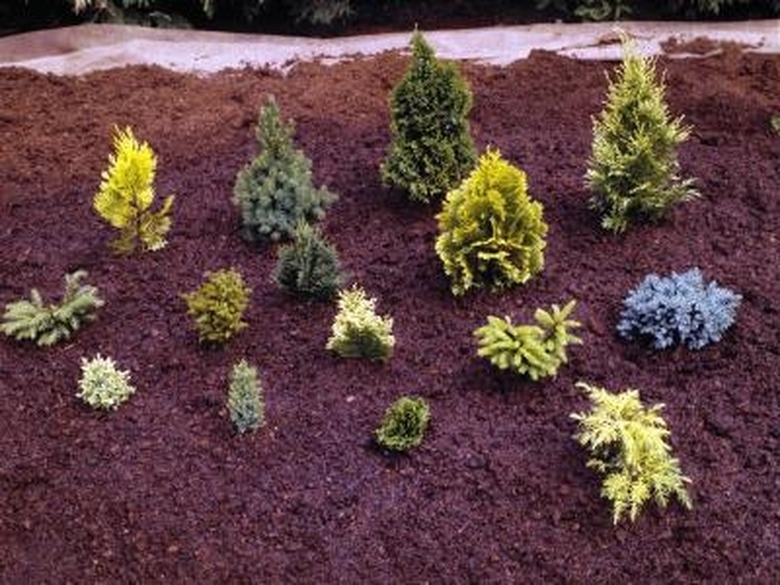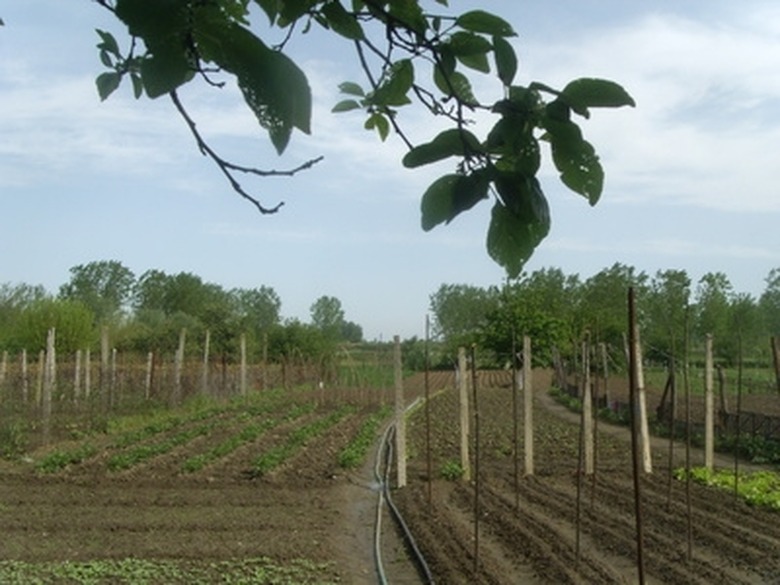Potassium Nitrate Fertilizer
Step 1
Step 1
Visit your local garden supply store and look for potassium nitrate by its most common alternative name–saltpeter. It may also be called "nitrate of potash" or "Vesta powder." It's also a main ingredient in Spectracide Stump Remover or Grant's Stump Remover.
Step 2
Visit the "Business and Industrial" category on the eBay website (see Resources). You can purchase potassium nitrate online from several different sellers.
Step 3
Visit the The Science Company website (see Resources) and purchase potassium nitrate there. Be advised the company does not accept returns, even if the containers are unopened.
- Visit your local garden supply store and look for potassium nitrate by its most common alternative name–saltpeter.
- Visit the The Science Company website (see Resources) and purchase potassium nitrate there.
Step 4
Visit the AmericaRx.com website (see Resources) to purchase Humco SaltPetre Powder (potassium nitrate).
How Should I Fertilize My Garden Soil Before Planting?
Step 1
Plants require 16 to 20 nutrients to develop strong roots, build an effective immune system and perform specific functions, such as blooming and producing food. Of those elements, nitrogen, phosphorous and potassium are needed in large quantities. But trace minerals, such as iron, zinc and boron are also vital for a plant's health. While they absorb some nourishment, such as carbon and hydrogen, from the air, vegetation gets most of its sustenance from the ground. As preparation for planting a garden, get your soil tested. Follow the fertilization recommendations the lab report provides, as well as a few general guidelines.
Step 2
- Visit the AmericaRx.com website (see Resources) to purchase Humco SaltPetre Powder (potassium nitrate).
- But trace minerals, such as iron, zinc and boron are also vital for a plant's health.
Step 1
Remove weeds, grass and rocks from the planting site. Break the ground to a depth of 6 to 9 inches with a pickax and shovel. Use a rototiller over large areas.
Step 2
Spread a 2= to 3-inch layer of manure or other organic matter over the turned soil. Till it 6 to 9 inches into the soil. The amendment improves water and air circulation underground. It also stores nutrients in the soil particles for slow release to the plants.
Step 3
- Remove weeds, grass and rocks from the planting site.
- Spread a 2= to 3-inch layer of manure or other organic matter over the turned soil.
Step 4
Broadcast the fertilizers recommended in your soil test report over the planting bed. Use a spreader for fertilizer applications. In the absence of a soil test, apply 2 to 3 lbs. per 100 square feet of a formula designed for the crop you are growing. Salad greens need high doses of nitrogen, for instance. Give them a feed with a 15-15-15 analysis. Then numbers indicate the percentage of the macronutrients nitrogen, phosphorous and potassium present in the product. Work the fertilizer into the soil.
Step 5
- Broadcast the fertilizers recommended in your soil test report over the planting bed.
Step 6
Rake the bed surface to smooth it out for planting.
Step 1
Read the individual amounts of nitrogen, phosphorous and potassium listed on the package of fertilizer you are using.
Step 2
Write the number of pounds of each element, and state the numbers as a ratio by inserting colons. For instance, if the fertilizer contains 10 pounds of nitrogen, five pounds of phosphorous and 10 pounds of potassium, write 10:5:10.
Step 3
Reduce the numbers, if possible. For instance, 10:5:10 can be reduced to 2:1:2.
Step 1
Step 1
Till the soil in the potassium-deficient garden beds to a depth of 1 foot.
Step 2
- Rake the bed surface to smooth it out for planting.
- Write the number of pounds of each element, and state the numbers as a ratio by inserting colons.
Step 3
Add 1 to 3 lbs. potassium to the soil per 1,000 square feet, depending on the severity of the potassium deficiency. The North Carolina State University Extension Service says that to add 1 to 3 lbs. of potassium per 1,000 sq. ft., you need to use 1.7 to 5 lbs. potassium chloride, 2.3 to 6.8 lbs. potassium nitrate or 2.1 to 6.3 lbs potassium sulfate. Use alternative, organic options such as greensand, kelp or granite meal if desired. Adjust the amounts depending on the size of the area being amended.
Step 4
- potassium to the soil per 1,000 square feet, depending on the severity of the potassium deficiency.
Step 5
Till the amendments into the soil thoroughly.
Step 6
Wait three or four months, then perform a soil test on the area. Examine the results to determine whether the amendment was enough to correct the potassium deficiency or if further steps need to be taken.
Step 7
Apply a potassium-rich fertilizer to the soil if the test shows the mineral is still below desired levels. Look for a fertilizer with a high (K) rating, which is the symbol for potassium. Follow the directions on the labeling when applying the fertilizer.
Step 8
Test the soil again before adding more potassium to the soil. Avoid overloading the soil with potassium, which can stunt root growth and deplete magnesium levels.
Step 9
- Till the amendments into the soil thoroughly.
- Follow the directions on the labeling when applying the fertilizer.
Step 1
Dissolve the potash fertilizer in warm water. It is much easier to use liquid fertilizer on container gardens than powder or granule forms. Use about two cups of fertilizer to a gallon of water to make a solution. Label this jug clearly as potash solution.
Step 2
Mix the potash solution with water. Use about 2 tbsp. of the solution in a gallon of water.
- Dissolve the potash fertilizer in warm water.
- Use about two cups of fertilizer to a gallon of water to make a solution.
Step 3
Water your container garden with the lighter potash solution and water mix. Do this once a day, depending on the needs of your plants.
Step 4
After a week, check the soil again. If it is now adequate in potash, you can begin using a more balanced liquid fertilizer that includes nitrogen and phosphates. You can prepare this in the same way as the potash-only liquid fertilizer.
Tip
The reason to avoid straight powdered or granulated fertilizer in container gardening is that the limited space makes it easy to burn plant leaves,stems or roots with the application of fertilizer. Making a liquid solution dilutes the fertilizer and prevents this from happening.
Things Needed
- Gallon plastic jug
- Potassium (potash) fertilizer mix
- Water
- Garden gloves
Balance is the key when feeding a new flowering perennial bed. Use a soil test to determine imbalances in the pH level and the amounts of nitrogen, phosphorous or potassium; adjust accordingly. As a general rule, too much manure or other forms of nitrogen will give you all leaf and no flower. Apply a good "general purpose" bagged fertilizer (usually 5-10-10) every spring.
- Water your container garden with the lighter potash solution and water mix.
- As a general rule, too much manure or other forms of nitrogen will give you all leaf and no flower.
Step 1
Put on a pair of rubber gloves.
Step 2
Stir 3.5 oz. of the potassium nitrate crystals into 1 qt. of room-temperature water until they dissolve.
Step 3
Put your seeds in the solution. Let the seeds soak in the solution for 30 minutes.
Step 4
Remove the seeds from the water and let them air-dry. Do not rinse.
- Put on a pair of rubber gloves.
- Remove the seeds from the water and let them air-dry.
Step 5
Plant the seeds.
Tip
The effectiveness of potassium nitrate in breaking seed dormancy depends a great deal on the type of seed involved. Experiments using a 10-minute soak of potassium nitrate to break the dormancy of sunflower seeds resulted in 83 percent germination in four days and 88 percent germination in seven days. Soaking seeds longer than 10 minutes is generally recommended. The general range of times for soaking seeds in a solution of potassium nitrate and water is 20 to 40 minutes.
Warning
Potassium nitrate is a strong oxidizer. Store it in a tightly-closed container away from combustible materials. Do not inhale it or swallow it. Do not allow it to come into contact with your skin. Use only in an area that is well-ventilated. Use rubber gloves when you handle it. It can cause redness and burning if you get it in your eyes. If you inhale it, get some fresh air. If you get it in your eyes or on your skin, wash your eyes or skin.
Things Needed
- Rubber gloves
- 3.5 oz. of potassium nitrate crystals
- 1 qt. of room-temperature water
Step 1
Watch for older leaves that turn yellow, while younger leaves appear green and healthy, along with general plant weakness, which indicates a nitrogen deficiency in the soil, according to the University of Nevada "Recognizing Plant Nutrient Deficiencies" fact sheet. Nitrogen promotes lush foliage and better productivity. Correct nitrogen deficiencies by amending the soil. Good sources of nitrogen are soybean meal, fish meal, blood meal and bat guano.
Step 2
Recognize purplish or bronze-colored leaves as a phosphorus deficiency in the soil, as noted in "Recognizing Plant Nutrient Deficiencies." Phosphorus promotes rapid growth, strong root systems and big blooms. Add bone meal, colloidial phosphorous or rock phosphate to the soil to increase phosphorous content.
- Watch for older leaves that turn yellow, while younger leaves appear green and healthy, along with general plant weakness, which indicates a nitrogen deficiency in the soil, according to the University of Nevada "Recognizing Plant Nutrient Deficiencies" fact sheet.
Step 3
Be aware of potassium deficiency, indicated by leaves with yellow, translucent spots and browning edges. Potassium builds protein, aides in photosynthesis, and builds disease resistance. Soil also provides secondary nutrients and minerals that plants need. Sources of potassium include ground kelp, greensand or granite dust.
Tip
Amend soil with organic materials to prevent nutrient imbalances. Organic content in the soil affects soil fertility and plant productivity. Increasing organic matter in soil also improves soil structure and increases biological activity, making nutrients more readily available for plant use. Compost is one of the most complete soil amendments that you can get. Turn one to two inches of compost into the soil during soil preparation at the beginning of each season, and supplement with regular top dressings to provide plants with the nutrients that they need.
Warning
Excesses of mineral nutrients can be as detrimental as nutrient deficiencies are. Mineral nutrients such as potassium, calcium, nitrate-nitrogen, and magnesium may cause deficiencies of other soil nutrients, while excesses of other mineral nutrients can result in soil toxicity.


